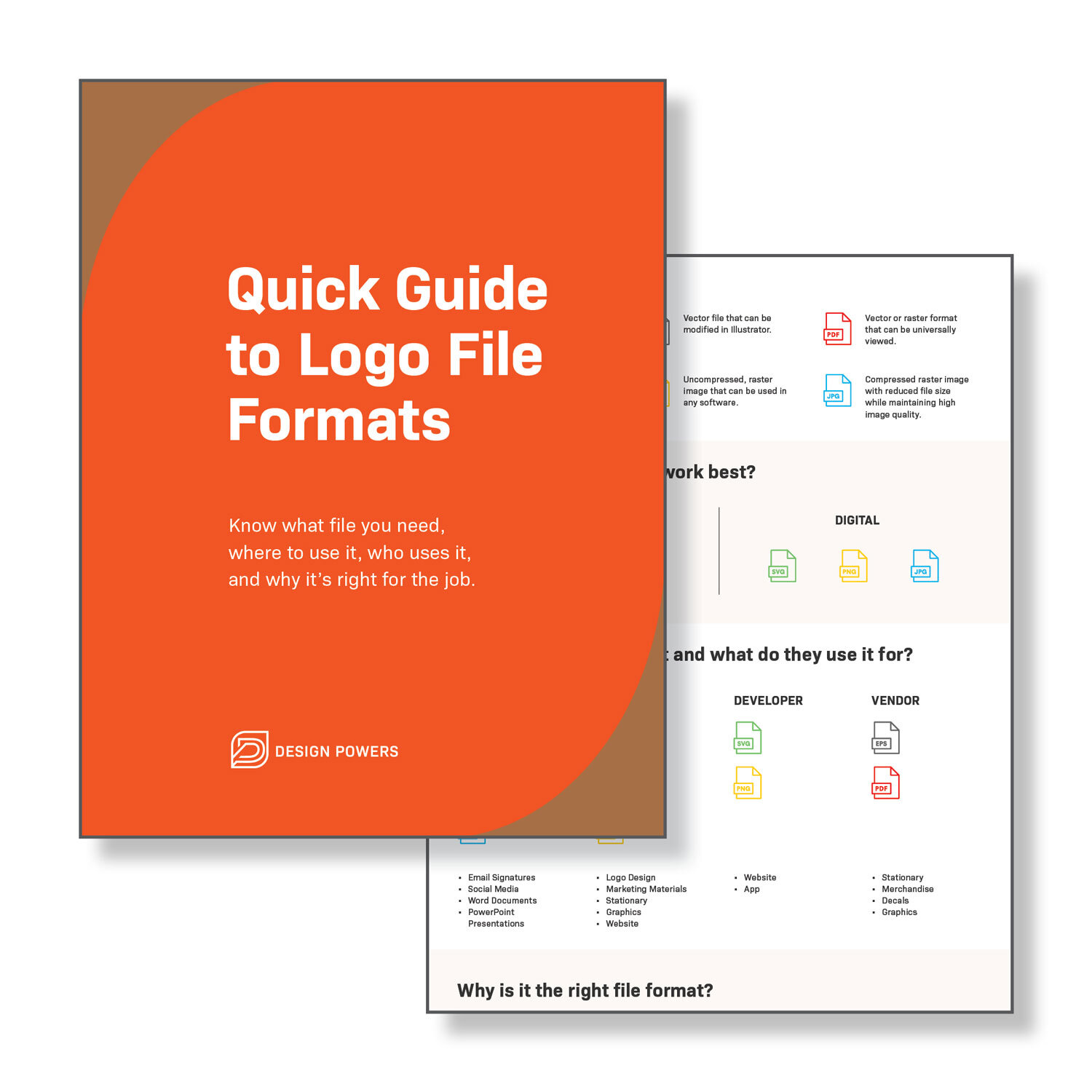Redesigning the Arlington Chamber of Commerce Logo
A logo is a recognizable graphic element, often including a name, symbol, or trademark that represents an organization or product. It is one of the most important design elements because it creates the basis for all your other marketing initiatives: website, business cards, signage, and advertising. A logo sends the overall message about your business brand.
Often one of the first things a business does when they start out is to create a logo. Perhaps they DIY, ask an “artsy” friend or hire an online vendor - based solely on cost. It’s unfortunate because that initial mark may wind up being the logo for the business for a long time.
We recommend working with a design professional right from the start so your logo accurately reflects your business professionally and gives your potential clients the confidence they need to buy from you.
“...if it isn’t easy to understand how to buy from you and easy on the eyes, your potential client is gone. ”
There are many costs associated with running a business and it can be pretty tempting to cut corners, but a poorly executed visual and content hierarchy has an opportunity cost. Did you know that 94% of online first impressions are design-related? 63% of purchasing decisions are based on color alone! Scarily, 93% of the time that someone leaves a website, it’s for design or usability reasons. That means if it isn’t easy to understand how to buy from you AND easy on the eyes, your potential client is gone. A well-crafted story and brand will reap benefits for years to come and will spark joy ✨ sales 💵 and how ’bout a bit of pride! 😀
The following article outlines how after an extensive RFI process, The Arlington Chamber of Commerce, a non-profit organization started in 1924, selected Design Powers to redesign their logo. We’re honored to have been given this opportunity as the Chamber is an Arlington institution and maintains an important role in connecting the business, nonprofit, investment and philanthropic communities of this dynamic county.
Reading this case study will give you an insight into the logo design process and what to expect when you hire a professional designer to create a lasting mark.
Understanding the Past and the Vision for the Future
Every design project begins with discovery and this one was no different. To define our goals we must understand our client, their history, and what they hope to achieve with the redesign.
The assignment was strictly a redesign of their logo and not a total brand refresh. Their current logo, was about 20 years old and no longer worked well within today’s media. The first issue was visual hierarchy.
This image shows the very first Chamber logo in the bottom right in use until the 1980s. The logo on the left represented the Chamber from 1980s–2000s then finally the last logo in the upper right in use until now.
The emphasis was on the words “The Chamber” and the organization’s name “Arlington Chamber of Commerce” was crammed between it and the three word tagline which was now considered dated.
The stated goals:
Increased prominence of the location ARLINGTON
Be scalable (lapel pins to signage)
Useful as an icon
Refresh the blue color palette
Be world-class (uh 😬 no pressure)
Initial Concepts
After the initial meeting with the Chamber President, Kate Bates and Board Chair, Greg Hamilton, I researched other Chamber logos and created a Pinterest board. It’s always insightful to see what others do before brainstorming ideas. I decided on three concept directions based on our discovery meeting and the goals.
One piece of added value that the Chamber had in hiring me is my thirty years as a resident of Arlington and my twenty years of doing graphic design work for Arlington County. I’m very familiar with our county map and the storied history behind it’s formation. I knew one of my concepts would include it and Greg and I agreed that I should give it a try. It’s quite a challenging shape but very unique.
The first concept used the aforementioned county shape to abstractly evoke both tech and nature. It featured three-colored vertical bars that varied in length suggesting a river, buildings and sky. It also had a sound wave/tech vibe that undulates. I abbreviated to ARL so I could nestle the map icon into the type creating a rectangle. I also wanted to see if it would be a viable option. The typeface, Gravesends, is a newly designed typeface influenced by the crisp, geometric san serifs of the 1920s — a homage to the Chamber’s beginnings.
The second concept was a play on using the @ symbol. The @ symbol is a necessary keystroke for links, connection AND conveniently an A! I was thinking about #3 in the stated goals — a useful icon, so I surrounded the “a” with two “c”s and tucked a playful tagline “Where It’s At!” into the circle. I used the italicized version of typeface, Bree, for “Arlington” because it’s modern with a bit of whimsy in the “g”.
Left to right: Shirlington Gateway which ushers all into South Arlington. It’s a multi-tenant building w/ several kinds of companies as well as VHC. I love the Brancusi-like shape and how it’s sighted. Next is the DCA Air Traffic Control Tower, designed by architect Cesar Pelli. National Airport’s history and importance to the business community goes without saying. The front facade representing small businesses is inspired by Westover in the western part of the county. The trees are a nod to our beloved parks and trails which many use to commute to work. The Air Force Memorial reflects the military and tourist presence and the Nestlé building in Rosslyn represents big businesses.
The last concept was illustrative. I had in mind other Chamber logos that featured their skyline. I didn’t want to focus on just one skyline in Arlington though so I drew landmark buildings that represented different regions of the county as well as different business sectors. Admittedly, this concept is a bit of a throw back and probably too detailed for a usable logo but often when I do initial concepts, I go “junk drawer” and if it gets picked, I “Marie Kondo.”
As an aside, I designed two more concepts but decided they didn’t pass the “what if the client actually likes it” test. This is something I’ve learned the hard way after presenting logo concepts that weren’t worthy of submission but I included anyway. “Uh, that’s not the one you were supposed to go with.” 🤔 Now I have to be confident in a logo’s overall conceptual merit and usability - which means no more than two or three concepts. If it were a logo for a product or a large company, the research and iterations would be more thorough but for small businesses (who we mostly work with), it’s not necessary.
First Client Critique
The Arlington Chamber of Commerce assembled a small task force to debate the merits of each concept. Critiques are one of my most favorite things — it’s my ENTP personality type. I love putting my work up there and “throwing a few darts at it.” My MICA education prepared me well. 👩🎨
The task force really liked the first concept but preferred the third concept’s typography. The map icon still needed refinement and the three colors were problematic because the Chamber still uses a lot of one-color communication. They definitely did not want to abbreviate their name to ARL or ACC. I waxed on about the merits of using just “Arlington Chamber.” No dice, they felt “of Commerce” was still needed.
After playing with the map icon, smoothing it out, outlining it, refining the edges, I knew I had to abandon the three color concept even though I was attached to it. 😞 There wasn’t a way to translate it into one color and grayscale wasn’t appealing.
Final Logo
There was another round of conversation done through explainer videos and email with Kate and Greg and then the final task force meeting. We debated blues and teals, uppercase vs. upper and lowercase, and finally, the icon in relation to the name. I created mockups showing what the logo would look like on letterhead, the member plaque and of course the website. We had a winner…
The final two-color rendition of the logo
The Unveiling
Following the final review and the logo completion we delivered it in EPS, PNG, JPG, and PDF formats. We also created a comprehensive logo style guide delineating proper usage of colors, positioning and typography.
With the logo officially blessed and within deadline, the Chamber used their Annual Meeting at the end of the year to unveil it–that’s three hundred and fifty colleagues simultaneously looking at my work. 😳
Since then, it’s been incorporated into their environment and on all their varied communications. It’s exciting to have designed a mark that will be in use for quite some time. Perhaps twenty years from now the next designer will look at it and think “This needs to be holographic!”
Left side: old logo / Right Side: new logo
Conclusion
Designing a logo requires goals, research, exploration and an outlined creative process. Budget and timeline impact how we execute too, but for the most part this is an accurate reflection of our logo design process.
Want to discuss anything you’ve read here or maybe you’d like us to create something distinctive and lasting for your business? Let’s chat! Check out other logos we designed.
Quick Guide to Logo File Formats
Download our free Quick Guide to Logo File Formats to know what file you need, where to use it, who uses it and why it’s right for the job.











